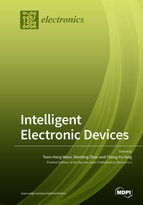Intelligent Electronic Devices
A special issue of Electronics (ISSN 2079-9292). This special issue belongs to the section "Artificial Intelligence".
Deadline for manuscript submissions: closed (31 March 2020) | Viewed by 69496
Special Issue Editors
Interests: IOT devices; photovoltaic devices; STEM education
Special Issues, Collections and Topics in MDPI journals
Interests: fault-tolerant computing; computer and network security; peer-to-peer and grid computing; performance evaluation of distributed systems
Special Issues, Collections and Topics in MDPI journals
Interests: electronic ceramics; high-frequency communication materials; applied science
Special Issues, Collections and Topics in MDPI journals
Special Issue Information
Dear Colleagues,
In a modern technological society, electronic engineering and design innovations are both academic and practical engineering fields that involve systematic technological materialization through scientific principles and engineering designs. Engineers and designers must work together with a variety of other professionals in their quest to find systems solutions to complex problems. Fast advances in science and technology have broadened the horizons of engineering whilst simultaneously creating a multitude of challenging problems in every aspect of modern life. Current research is interdisciplinary in nature, reflecting a combination of concepts and methods that often span several areas of mechanics, mathematics, electrical engineering, control engineering, and other scientific disciplines.
In addition, our organized conference “The 2nd IEEE International Conference on Knowledge Innovation and Invention 2019” (IEEE ICKII 2019) will be held in Seoul, South Korea on 12–15 July 2019. The authors of the papers that will be presented at IEEE ICKII 2019 about the topics are invited to submit their extended versions to this Special Issue after the conference. Submitted papers should be extended to the size of regular research or review articles, with at least a 50% extension of new results.
Technological innovation by electronic engineering includes electrical circuits and devices, computer science and engineering, communications and information processing, and electrical engineering communications. The main goal of this Special Issue “Intelligent Electronic Devices” is to discover new scientific knowledge relevant to the following topics:
- Electrical circuits and devices;
- Microelectronics and computer technology;
- Computer science and engineering;
- Communications and information processing;
- Electrical engineering communications;
- Signal processing;
- Measurements technology;
- Microwave and electronic system engineering;
- Microelectronics and optoelectronics;
- Systems and control engineering;
Prof. Dr. Teen-Hang Meen
Prof. Dr. Wenbing Zhao
Prof. Dr. Cheng-Fu Yang
Guest Editors
Manuscript Submission Information
Manuscripts should be submitted online at www.mdpi.com by registering and logging in to this website. Once you are registered, click here to go to the submission form. Manuscripts can be submitted until the deadline. All submissions that pass pre-check are peer-reviewed. Accepted papers will be published continuously in the journal (as soon as accepted) and will be listed together on the special issue website. Research articles, review articles as well as short communications are invited. For planned papers, a title and short abstract (about 100 words) can be sent to the Editorial Office for announcement on this website.
Submitted manuscripts should not have been published previously, nor be under consideration for publication elsewhere (except conference proceedings papers). All manuscripts are thoroughly refereed through a single-blind peer-review process. A guide for authors and other relevant information for submission of manuscripts is available on the Instructions for Authors page. Electronics is an international peer-reviewed open access semimonthly journal published by MDPI.
Please visit the Instructions for Authors page before submitting a manuscript. The Article Processing Charge (APC) for publication in this open access journal is 2400 CHF (Swiss Francs). Submitted papers should be well formatted and use good English. Authors may use MDPI's English editing service prior to publication or during author revisions.
Keywords
- Electrical circuits and devices
- Computer science and engineering
- Communications and information processing
- Electrical engineering communications








